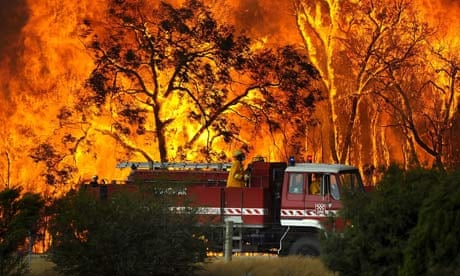Marysville is the town that disappeared. Once known as Melbourne's honeymooning centre, with its pretty guesthouses and century-old oaks, the town, about 60 miles from the Victoria state capital, is now a smouldering, post-apocalyptic wasteland.
From the air, nearby St Fillans resembles a row of campfires - piles of powdery ashes with the embers trampled out. The landscape is deserted, with caravans, boats and burned-out cars abandoned in the middle of roads. Many appear to have been trapped by flying debris - huge sections of what were once walls which have blocked the road. A house under construction is untouched by fire, but the savage winds have scattered its beams, like a child's game of pick-up sticks amid the scorched earth and blankets of smoke.
Some calamity appears to have destroyed civilization - it's like a film set, perhaps for Cormac McCarthy's post-nuclear novel The Road.
On the Maroondah Highway a shrouded corpse lies on scarred earth, surrounded by police tape. Black dots under trees turn out to be fried animals.
The horror of those furious minutes when panicked residents tried to flee the firefront is evident on a road that connects the towns of Whittlesea and Kinglake.
Cars litter the road, crashed and abandoned. In many cases, the cars that people sought as their only hope of survival, became their tombs.
On one corner just west of Kinglake, six cars lie, four completely burned out. They rest in ditches and crashed into fallen tree limbs. A motorbike lies, crashed into a tree, on the side of the road. Molten metal, car parts melted into the road, are a sign of the heat that tore through.
Elsewhere on the road there are cars that have crashed head-on.
Bodies are still being removed from the burned-out shells. Police scientists and coroners are on the scene. The official death toll in Kinglake is 12. In nearby Kinglake West, another 10.
But there are still, almost certainly, other bodies not yet found, people unaccounted for. Fire crews are moving from house to house, checking each room, every shed, every water tank.
Survivors described the firefront, fanned by the changed wind direction, as ferocious - and fast. Maryanne Mercuri was listening to the radio news for fire updates. Kinglake wasn't mentioned.
"Within two minutes, the sky went black with smoke, it was black like it was midnight, and the fire was right there. There was nothing we could do. We couldn't escape, we couldn't go anywhere," she said. "Fire was falling from the sky, huge shoots of flame. Mercuri, her husband, Rod, and children Allison, 11, and Dean and Kirk, both nine, took shelter first in the garage. When that caught fire, they ran to their shed, before running back to the house. She covered the children with towels, just something to protect them from the scorching heat.
"We didn't have time to wet them, I couldn't even see them, it was just whatever I could grab in the dark and the smoke," she said.
"They were good kids, they were really good kids. But we were all scared. We were all so scared. We even talked about heaven."
In the town of Narbethong, where the charred ground crunches underfoot, it is eerily silent. There is no noise, no birds. Rows of houses have been destroyed, a melted truck still burns, the corrugated iron of water tanks is twisted like plasticine. Only the metal clothes lines survived intact.
